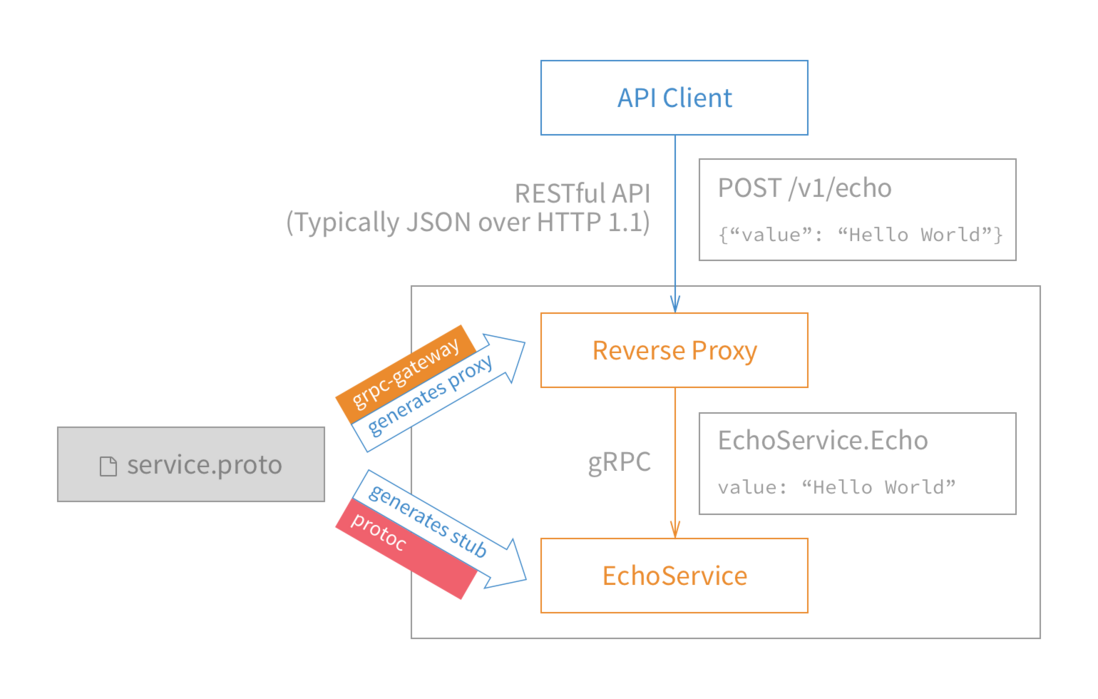gRPC HTTP协议转换
正当有这个需求的时候,就看到了这个实现姿势。源自coreos的一篇博客,转载到了grpc官方博客gRPC with REST and Open APIs。
etcd3改用grpc后为了兼容原来的api,同时要提供http/json方式的API,为了满足这个需求,要么开发两套API,要么实现一种转换机制,他们选择了后者,而我们选择跟随他们的脚步。
他们实现了一个协议转换的网关,对应github上的项目grpc-gateway,这个网关负责接收客户端请求,然后决定直接转发给grpc服务还是转给http服务,当然,http服务也需要请求grpc服务获取响应,然后转为json响应给客户端。结构如图:
下面我们就直接实战吧。基于hello-tls项目扩展,客户端改动不大,服务端和proto改动较大。
安装grpc-gateway
go get -u github.com/grpc-ecosystem/grpc-gateway/protoc-gen-grpc-gateway
项目结构:
$GOPATH/src/grpc-go-practice/
example/
|—— hello-http-2/
|—— client/
|—— main.go // 客户端
|—— server/
|—— main.go // 服务端 |—— keys/ // 证书目录 |—— server.key |—— server.pem |—— proto/ |—— google // googleApi http-proto定义 |—— api |—— annotations.proto |—— annotations.pb.go |—— http.proto |—— http.pb.go |—— hello_http.proto // proto描述文件 |—— hello_http.pb.go // proto编译后文件 |—— hello_http_pb.gw.go // gateway编译后文件这里用到了google官方Api中的两个proto描述文件,直接拷贝不要做修改,里面定义了protocol buffer扩展的HTTP option,为grpc的http转换提供支持。
示例代码
proto/hello_http.proto
syntax = "proto3"; // 指定proto版本
package proto; // 指定包名
import "google/api/annotations.proto"; // 定义Hello服务 service HelloHttp { // 定义SayHello方法 rpc SayHello(HelloHttpRequest) returns (HelloHttpReply) { // http option option (google.api.http) = { post: "/example/echo" body: "*" }; } } // HelloRequest 请求结构 message HelloHttpRequest { string name = 1; } // HelloReply 响应结构 message HelloHttpReply { string message = 1; }这里在原来的SayHello方法定义中增加了http option, POST方式,路由为"/example/echo"。
编译proto
cd $GOPATH/src/grpc-go-practice/example/hello-http-2/proto
# 编译google.api
protoc -I . --go_out=plugins=grpc,Mgoogle/protobuf/descriptor.proto=github.com/golang/protobuf/protoc-gen-go/descriptor:. google/api/*.proto # 编译hello_http.proto protoc -I . --go_out=plugins=grpc,Mgoogle/api/annotations.proto=git.vodjk.com/go-grpc/example/proto/google/api:. ./*.proto # 编译hello_http.proto gateway protoc --grpc-gateway_out=logtostderr=true:. ./hello_http.proto注意这里需要编译google/api中的两个proto文件,同时在编译hello_http.proto时指定引入包名,最后使用grpc-gateway编译生成hello_http_pb.gw.go文件,这个文件就是用来做协议转换的,查看文件可以看到里面生成的http handler,处理上面定义的路由"example/echo"接收POST参数,调用HelloHTTP服务的客户端请求grpc服务并响应结果。
server/main.go
package main
import (
"crypto/tls"
"fmt"
"io/ioutil" "log" "net" "net/http" "strings" "github.com/grpc-ecosystem/grpc-gateway/runtime" "golang.org/x/net/context" "google.golang.org/grpc" pb "git.vodjk.com/go-grpc/example/proto" "google.golang.org/grpc/credentials" "google.golang.org/grpc/grpclog" ) // 定义helloHttpService并实现约定的接口 type helloHttpService struct{} // HelloHttpService ... var HelloHttpService = helloHttpService{} func (h helloHttpService) SayHello(ctx context.Context, in *pb.HelloHttpRequest) (*pb.HelloHttpReply, error) { resp := new(pb.HelloHttpReply) resp.Message = "Hello " + in.Name + "." return resp, nil } // grpcHandlerFunc 检查请求协议并返回http handler func grpcHandlerFunc(grpcServer *grpc.Server, otherHandler http.Handler) http.Handler { return http.HandlerFunc(func(w http.ResponseWriter, r *http.Request) { // TODO(tamird): point to merged gRPC code rather than a PR. // This is a partial recreation of gRPC's internal checks https://github.com/grpc/grpc-go/pull/514/files#diff-95e9a25b738459a2d3030e1e6fa2a718R61 if r.ProtoMajor == 2 && strings.Contains(r.Header.Get("Content-Type"), "application/grpc") { grpcServer.ServeHTTP(w, r) } else { otherHandler.ServeHTTP(w, r) } }) } func main() { endpoint := "127.0.0.1:50052" // 实例化标准grpc server creds, err := credentials.NewServerTLSFromFile("../../keys/server.pem", "../../keys/server.key") if err != nil { grpclog.Fatalf("Failed to generate credentials %v", err) } conn, _ := net.Listen("tcp", endpoint) grpcServer := grpc.NewServer(grpc.Creds(creds)) pb.RegisterHelloHttpServer(grpcServer, HelloHttpService) // http-grpc gateway ctx := context.Background() ctx, cancel := context.WithCancel(ctx) defer cancel() dcreds, err := credentials.NewClientTLSFromFile("../../keys/server.pem", "server name") if err != nil { grpclog.Fatalf("Failed to create TLS credentials %v", err) } dopts := []grpc.DialOption{grpc.WithTransportCredentials(dcreds)} gwmux := runtime.NewServeMux() err = pb.RegisterHelloHttpHandlerFromEndpoint(ctx, gwmux, endpoint, dopts) if err != nil { fmt.Printf("serve: %v\n", err) return } mux := http.NewServeMux() mux.Handle("/", gwmux) if err != nil { panic(err) } // 开启HTTP服务 cert, _ := ioutil.ReadFile("../../keys/server.pem") key, _ := ioutil.ReadFile("../../keys/server.key") var demoKeyPair *tls.Certificate pair, err := tls.X509KeyPair(cert, key) if err != nil { panic(err) } demoKeyPair = &pair srv := &http.Server{ Addr: endpoint, Handler: grpcHandlerFunc(grpcServer, mux), TLSConfig: &tls.Config{ Certificates: []tls.Certificate{*demoKeyPair}, }, } fmt.Printf("grpc and https on port: %d\n", 50052) err = srv.Serve(tls.NewListener(conn, srv.TLSConfig)) if err != nil { log.Fatal("ListenAndServe: ", err) } return } 好吧,这么大一坨。核心就是开启了一个http server,收到请求后检查请求是grpc还是http,然后决定是由grpc服务直接处理还是交给gateway做转发处理。其中grpcHandlerFunc函数负责处理决定用哪个handler处理请求,这个方法是直接Copy过来用的,原文的注释说他们也是从别处Copy的。感谢贡献者。
基本流程:
-
实例化标准grpc server
-
将grpc server注册给gateway
-
开启http服务,handler指定给grpcHandlerFunc方法
注意:必须开启HTTPS
运行结果
开启服务:
# hello-http-2/server
go run main.go
> grpc and https on port: 50052 调用grpc客户端:
# hello-http-2/client
go run main.go
> Hello gRPC.请求https:
curl -X POST -k https://localhost:50052/example/echo -d '{"name": "gRPC-HTTP is working!"}' > {"message":"Hello gRPC-HTTP is working!."}为什么是hello-http-2,因为1是个不完整的实现姿势,可以不用https,但是需要分别开启grpc服务和http服务,这里不做说明了。
